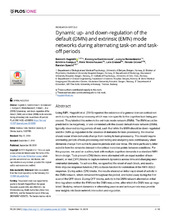| dc.contributor.author | Hugdahl, Kenneth | |
| dc.contributor.author | Kazimierczak, Katarzyna Anna | |
| dc.contributor.author | Beresniewicz, Justyna | |
| dc.contributor.author | Kompus, Kristiina | |
| dc.contributor.author | Westerhausen, René | |
| dc.contributor.author | Ersland, Lars | |
| dc.contributor.author | Grüner, Renate | |
| dc.contributor.author | Specht, Karsten | |
| dc.date.accessioned | 2020-03-16T09:29:52Z | |
| dc.date.available | 2020-03-16T09:29:52Z | |
| dc.date.issued | 2019 | |
| dc.Published | Hugdahl K, Kazimierczak KA, Beresniewicz J, Kompus K, Westerhausen R, Ersland L, Grüner R, Specht K. Dynamic up- and down-regulation of the default (DMN) and extrinsic (EMN) mode networks during alternating task-on and task-off periods. PLOS ONE. 2019;9:e0218358 | eng |
| dc.identifier.issn | 1932-6203 | |
| dc.identifier.uri | https://hdl.handle.net/1956/21502 | |
| dc.description.abstract | Using fMRI, Hugdahl et al. (2015) reported the existence of a general-domain cortical network during active task-processing which was non-specific to the cognitive task being processed. They labelled this network the extrinsic mode network (EMN). The EMN would be predicted to be negatively, or anti-correlated with the classic default mode network (DMN), typically observed during periods of rest, such that while the EMN should be down-regulated and the DMN up-regulated in the absence of demands for task-processing, the reverse should occur when demands change from resting to task-processing. This would require alternating periods of task-processing and resting and analyzing data continuously when demands change from active to passive periods and vice versa. We were particularly interested in how the networks interact in the critical transition points between conditions. For this purpose, we used an auditory task with multiple cognitive demands in a standard fMRI block-design. Task-present (ON) blocks were alternated with an equal number of task-absent, or rest (OFF) blocks to capture network dynamics across time and changing environmental demands. To achieve this, we specified the onset of each block, and used a finite-impulse response function (FIR) as basis function for estimation of the fMRI-BOLD response. During active (ON) blocks, the results showed an initial rapid onset of activity in the EMN network, which remained throughout the period, and faded away during the first scan of the OFF-block. During OFF blocks, activity in the DMN network showed an initial time-lag where neither the EMN nor the DMN was active, after which the DMN was up-regulated. Studying network dynamics in alternating passive and active periods may provide new insights into brain network interaction and regulation. | en_US |
| dc.language.iso | eng | eng |
| dc.publisher | PLOS | eng |
| dc.rights | Attribution CC BY | eng |
| dc.rights.uri | http://creativecommons.org/licenses/by/4.0 | eng |
| dc.title | Dynamic up- and down-regulation of thedefault (DMN) and extrinsic (EMN) modenetworks during alternating task-on and task-offperiods | eng |
| dc.type | Peer reviewed | |
| dc.type | Journal article | |
| dc.date.updated | 2019-11-14T11:53:46Z | |
| dc.description.version | publishedVersion | |
| dc.rights.holder | Copyright 2019 The Author(s) | eng |
| dc.identifier.doi | https://doi.org/10.1371/journal.pone.0218358 | |
| dc.identifier.cristin | 1727670 | |
| dc.source.journal | PLOS ONE | |

